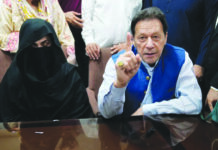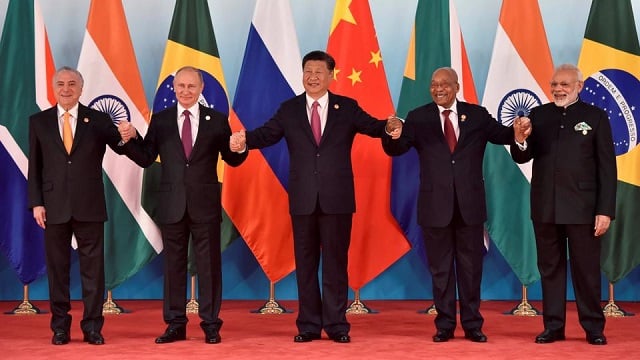ISLAMABAD: Nineteen countries, including Argentina, Turkey, Pakistan and Saudi Arabia, have expressed their interest in joining the BRICS, and these aspirations will be deliberated upon at the group’s upcoming summit in South Africa in August.
According to a report carried by Gwadar Pro on Thursday, developing economies, in particular, are harboring deep frustration over the onerous conditions imposed upon them by Western-dominated institutions. But perhaps the most significant source of discontent lies in their skepticism toward Western norms and values, viewing them as mere cover-ups for self-serving actions by Western powers.
The failure or reluctance of the West to reform global governance in a way that grants emerging economies like China greater influence has only compounded these grievances.
Amidst the ever-evolving global political and economic spectrum, we are witnessing the ascent of an interesting topic that promises to redefine global financial dynamics—the inception of a unified BRICS currency.
The formation of a collective currency is expected to be the most prominent subject of discourse, when the leaders of five emerging nations convene in Johannesburg in August for the BRICS summit.
Casting light on the audacious ambitions of these emerging economic powers, China is leading this momentum for an alternative monetary regime. Simultaneously, other members of the group lend their unwavering support to this visionary endeavor of China to challenge the veritable grip of U.S. “dollar hegemony”.
Such a stance befits China’s transformative rise on the global stage, unveiling its intent to reconfigure the existing financial order.
Emboldened by a shared aspiration, the BRICS nations converge upon the idea of unified currency. The proposed creation of a unified BRICS currency represents a clarion call for emancipation from the established conventions, a stride towards forging a new epoch of economic equilibrium. With the prospect of such a drastic shift on the horizon, the global financial system braces itself for a profound reordering, as the echoes of BRICS currency resonate across the globe.
While the prospect of a unified BRICS currency holds the allure of shifting power dynamics, it is not without its numerous obstacles. As the project takes shape, the nations involved must confront complex questions and unbolt the intricacies of forging a new path. The challenges, both practical and geopolitical, loom large, demanding careful deliberation and strategic maneuvering.
Since the culmination of World War II, the U.S. dollar has reigned supreme as the preeminent global currency. A staggering 80% of international transactions flow through its channels, while close to two-thirds of the currency reserves held by central banks are stored in the greenback. The U.S. capital markets, in turn, bask in their liquidity, embodies a pinnacle of financial prowess.
This status quo has endowed the United States with hegemonic influence and leverage in the international arena. The far reach of the dollar has facilitated in solidifying America’s position as an economic superpower.
The dollar’s dominance, however, is not without consequences. While it has bestowed undeniable advantages upon the United States, it has also attracted scrutiny and generated concerns among some actors in the international community.
The immense power wielded by the dollar has led to debates surrounding the potential vulnerabilities and asymmetries inherent in such a system. Critics argue that the inordinate reliance on a single currency in global transactions exposes economies to volatility and external shocks, underscoring the need for diversification and alternatives.
The push for de-dollarisation has returned with a vengeance after the Western sanction against Russia due to the Ukraine conflict. In an attempt to exert pressure on Russia, the United States imposed punitive sanctions last year, seizing an enormous $300 billion of Russia’s foreign currency reserves and excluding prominent Russian banks from the global interbank messaging system, SWIFT.
However, this strategy of “weaponizing” the dollar had an unintended outcome— it sparked the rise of alternative financial frameworks championed by Russia and China. As a consequence, there is a renewed momentum towards de-dollarization.
The vision of a BRIC alliance, originally conceived by former Goldman Sachs chief economist Jim O’Neill in 2001, took its time to materialize. It wasn’t until 2009, in the wake of a global financial meltdown, that the bloc convened for its inaugural summit in Yekaterinburg, Russia.
Driven together by the urgency of the economic crisis, the member states pledged to revamp international financial institutions to better reflect the shifting dynamics of the global economy. This entailed devising an alternative to the IMF and the World Bank, as well as challenging the entrenched dominance of the U.S. dollar.
The BRICS alliance, which turned from BRIC to BRICS after the induction of South Africa in 2010, has witnessed a wavy evolution, with its intentions occasionally questioned and its influence appearing uncertain.
As circumstances shift and economic realities unfold, the prospect of a genuine challenge to the established international financial architecture becomes a more tangible prospect. Yet another economic crisis, coupled with the cornering of one of the alliance’s most formidable members, BRICS’s drive to abandon the U.S.-led system has gained renewed attention.
Despite China being the only BRICS economy to sustain robust growth, the collective influence of the group has surpassed that of the G7 in terms of its relative contribution to global GDP, based on purchasing power parity. Moreover, bilateral trade between BRICS nations is experiencing a rapid ascent.
While progress toward the alliance’s broader aspirations seemed to have stalled, recent developments indicate a renewed sense of momentum. Discussions among members now revolve around the concept of “de-dollarizing” trade, with many passionately entertaining the idea of a shared BRICS currency.
A BRICS currency holds the potential to challenge the supremacy of the US dollar, or at the very least, unsettle its position of authority by facilitating cross-border trades among the BRICS members and like-minded countries.
Additionally, the BRICS bloc appears to be resurging as a platform for collaboration on various fronts, including climate change, global governance, and development.
BRICS nations seek a currency that ensures accessibility and equitable treatment in global trade, aiming to address the US dollar’s role as a tool for American hegemony, which they believe creates economic instability and hampers global recovery.
However, the process of establishing a common currency among a group of nations is typically a protracted bid, necessitating extensive cooperation over a span of years.
Drawing upon the example of the euro’s inception, the intricate nature of this undertaking, often entailing the gradual phasing out of local currencies. So far, Around 41 countries have shown interest in accepting and trading with BRICS currency.
They also include oil-rich nations from the Middle East. However, it appears that the current endeavors of the BRICS nations are primarily focused on formulating a currency unit specifically intended for facilitating cross-border trade, rather than a comprehensive replacement for individual national currencies.
This strategic approach mitigates some of the inherent complexities involved and lends credence to the plausibility of their collective efforts. By narrowing the scope, the BRICS nations seek to tread the path forward with increased feasibility, recognizing the potential benefits of a currency unit tailored for cross-border transactions.
The BRICS faces a multitude of challenges as more nations seek to join its ranks. The New Development Bank (NDB) struggles to overcome Western sanctions on Russia, a process that may take up to a decade. In response to investor concerns, the NDB halted its financial engagement with Russia and refrained from funding new projects in the country.
Furthermore, the NDB’s investment portfolio remains relatively modest, with around 96 projects funded, totaling $33 billion, compared to the World Bank’s disbursal of nearly $67 billion by June 2022. Additionally, vast geographical distances, differing political systems, trade imbalances, and geopolitical divergences among member states further strain cohesion.
Finally, expansion plans encounter disagreements regarding the criteria for new members. The BRICS must address these challenges to avoid stagnation under the load of internal contradictions.























